
Electricity generation is the process of generating electric power from sources of primary energy. For utilities in the electric power industry, it is the stage prior to its delivery to end users or its storage.
A nuclear electric rocket is a type of spacecraft propulsion system where thermal energy from a nuclear reactor is converted to electrical energy, which is used to drive an ion thruster or other electrical spacecraft propulsion technology. The nuclear electric rocket terminology is slightly inconsistent, as technically the "rocket" part of the propulsion system is non-nuclear and could also be driven by solar panels. This is in contrast with a nuclear thermal rocket, which directly uses reactor heat to add energy to a working fluid, which is then expelled out of a rocket nozzle.

Oak Ridge National Laboratory (ORNL) is a federally funded research and development center in Oak Ridge, Tennessee, United States. Founded in 1943, the laboratory is now sponsored by the United States Department of Energy and administered by UT–Battelle, LLC.

A pressurized water reactor (PWR) is a type of light-water nuclear reactor. PWRs constitute the large majority of the world's nuclear power plants. In a PWR, the primary coolant (water) is pumped under high pressure to the reactor core where it is heated by the energy released by the fission of atoms. The heated, high pressure water then flows to a steam generator, where it transfers its thermal energy to lower pressure water of a secondary system where steam is generated. The steam then drives turbines, which spin an electric generator. In contrast to a boiling water reactor (BWR), pressure in the primary coolant loop prevents the water from boiling within the reactor. All light-water reactors use ordinary water as both coolant and neutron moderator. Most use anywhere from two to four vertically mounted steam generators; VVER reactors use horizontal steam generators.

The Advanced Gas-cooled Reactor (AGR) is a type of nuclear reactor designed and operated in the United Kingdom. These are the second generation of British gas-cooled reactors, using graphite as the neutron moderator and carbon dioxide as coolant. They have been the backbone of the UK's nuclear power generation fleet since the 1980s.

The pebble-bed reactor (PBR) is a design for a graphite-moderated, gas-cooled nuclear reactor. It is a type of very-high-temperature reactor (VHTR), one of the six classes of nuclear reactors in the Generation IV initiative.

A nuclear power plant (NPP) is a thermal power station in which the heat source is a nuclear reactor. As is typical of thermal power stations, heat is used to generate steam that drives a steam turbine connected to a generator that produces electricity. As of 2022, the International Atomic Energy Agency reported there were 422 nuclear power reactors in operation in 32 countries around the world, and 57 nuclear power reactors under construction.

The RBMK is a class of graphite-moderated nuclear power reactor designed and built by the Soviet Union. The name refers to its design where, instead of a large steel pressure vessel surrounding the entire core, the core is surrounded by a cylindrical annular steel tank inside a concrete vault and each fuel assembly is enclosed in an individual 8 cm (inner) diameter pipe. The channels also contain the coolant, and are surrounded by graphite.
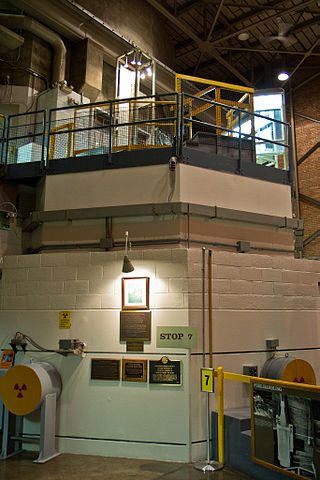
Experimental Breeder Reactor I (EBR-I) is a decommissioned research reactor and U.S. National Historic Landmark located in the desert about 18 miles (29 km) southeast of Arco, Idaho. It was the world's first breeder reactor. At 1:50 p.m. on December 20, 1951, it became one of the world's first electricity-generating nuclear power plants when it produced sufficient electricity to illuminate four 200-watt light bulbs. EBR-I subsequently generated sufficient electricity to power its building, and continued to be used for experimental purposes until it was decommissioned in 1964. The museum is open for visitors from late May until early September.

The Fort St. Vrain Nuclear Power Plant was a commercial nuclear power station located near the town of Platteville in northern Colorado in the United States. It operated from 1979 until 1989. It had a 330 MWe High-temperature gas reactor (HTGR). The plant was decommissioned between 1989 and 1992.
SM-1 was a 2-megawatt nuclear reactor developed by the American Locomotive Company (ALCO) and the United States Atomic Energy Commission (AEC) as part of the US Army Nuclear Power Program (ANPP) in the mid-1950s. The compact "package" reactor was designed to produce electricity and generate heat for remote military facilities. The first, the SM-1, served as the Army's primary training facility to train reactor operations personnel from all three services. In 1954, the Department of Defense placed the US Army in charge of all military nuclear power plants except those used for propulsion by the US Navy. The Army's Chief of Engineers established the US Army Engineer Reactors Group in April 1954, and decided to construct the SM-1 facility at the Corps of Engineers headquarters at Fort Belvoir, Virginia, about 18 miles south of Washington, D.C. About 800 personnel were trained on the SM-1 during its operational life, from 1957 to 1973. The power plant was shut down in March 1973, and is monitored within a "restricted access" section of the post. Inspectors enter the shut-down operations control room every decade or so. The Army plans to start demolition in 2020.
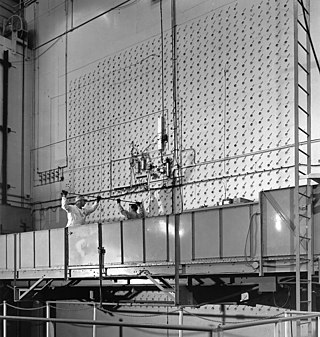
The X-10 Graphite Reactor is a decommissioned nuclear reactor at Oak Ridge National Laboratory in Oak Ridge, Tennessee. Formerly known as the Clinton Pile and X-10 Pile, it was the world's second artificial nuclear reactor, and the first designed and built for continuous operation. It was built during World War II as part of the Manhattan Project.
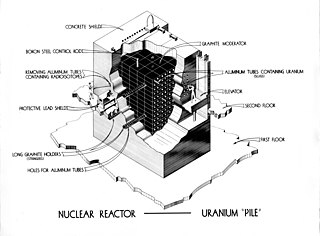
A graphite-moderated reactor is a nuclear reactor that uses carbon as a neutron moderator, which allows natural uranium to be used as nuclear fuel.

The Hallam Nuclear Power Facility (HNPF) in Nebraska was a 75 MWe sodium-cooled graphite-moderated nuclear power plant built by Atomics International and operated by Consumers Public Power District of Nebraska. It was built in tandem with and co-located with a conventional coal-fired power station, the Sheldon Power Station. The facility featured a shared turbo generator that could accept steam from either heat source, and a shared control room.
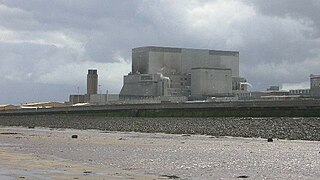
Hinkley Point B nuclear power station is a nuclear power station near Bridgwater, Somerset, on the Bristol Channel coast of south west England. It was the first commercial Advanced Gas Cooled reactor to generate power to the National Grid in 1976 and shares its design with sister station Hunterston B nuclear power station. It ceased operations permanently on 1 August 2022.
A load-following power plant, regarded as producing mid-merit or mid-priced electricity, is a power plant that adjusts its power output as demand for electricity fluctuates throughout the day. Load-following plants are typically in between base load and peaking power plants in efficiency, speed of start-up and shut-down, construction cost, cost of electricity and capacity factor.

The liquid fluoride thorium reactor is a type of molten salt reactor. LFTRs use the thorium fuel cycle with a fluoride-based molten (liquid) salt for fuel. In a typical design, the liquid is pumped between a critical core and an external heat exchanger where the heat is transferred to a nonradioactive secondary salt. The secondary salt then transfers its heat to a steam turbine or closed-cycle gas turbine.
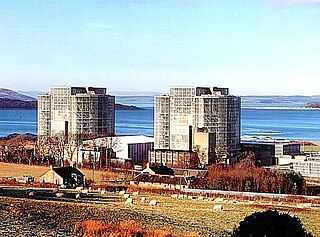
Hunterston A nuclear power station is a decommissioned Magnox nuclear power station located at Hunterston in Ayrshire, Scotland, adjacent to Hunterston B. The ongoing decommissioning process is being managed by Nuclear Decommissioning Authority (NDA) subsidiary Magnox Ltd.
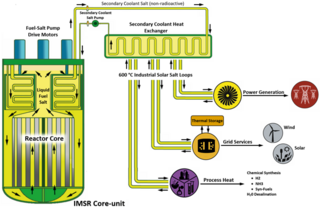
The Integral Molten Salt Reactor (IMSR) is a nuclear power plant design targeted at developing a commercial product for the small modular reactor (SMR) market. It employs molten salt reactor technology which is being developed by the Canadian company Terrestrial Energy. It is based closely on the denatured molten salt reactor (DMSR), a reactor design from Oak Ridge National Laboratory. It also incorporates elements found in the SmAHTR, a later design from the same laboratory. The IMSR belongs to the DMSR class of molten salt reactors (MSR) and hence is a "burner" reactor that employs a liquid fuel rather than a conventional solid fuel; this liquid contains the nuclear fuel and also serves as primary coolant.
Herbert G. MacPherson was an American nuclear engineer and deputy director of Oak Ridge National Laboratory (ORNL). He contributed to the design and development of nuclear reactors and in the opinion of Alvin Weinberg he was "the country's foremost expert on graphite"...
















